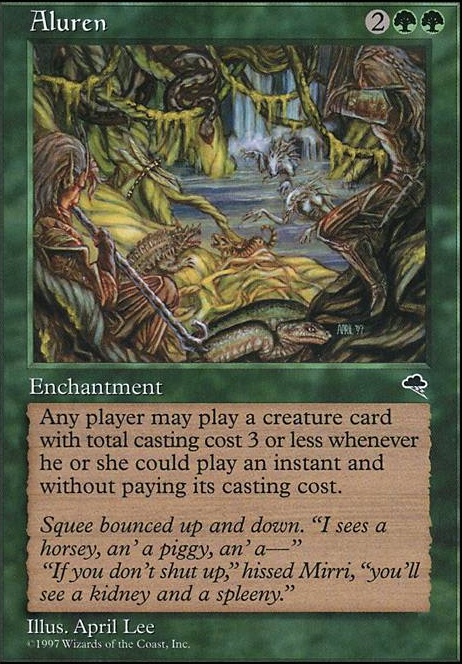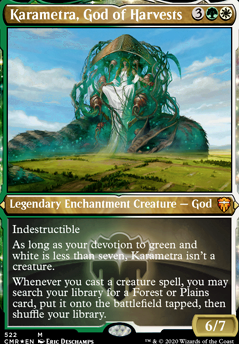Lands (34)
- 1x Bountiful Promenade
- 1x Branchloft Pathway Flip
- 1x Brushland
- 1x Canopy Vista
- 1x Command Tower
- 15x Forest
- 1x Gaea's Cradle
- 1x Horizon Canopy
- 1x Krosan Verge
- 1x Nykthos, Shrine to Nyx
- 3x Plains
- 1x Savannah
- 1x Scattered Groves
- 1x Scavenger Grounds
- 1x Temple Garden
- 1x Windswept Heath
- 1x Wooded Bastion
- 1x Yavimaya Hollow
Combo (6)
- 1x Whitemane Lion
- 1x Bontu's Monument
- 1x Fleetfoot Panther
- 1x Stonecloaker
- 1x Aluren
-
1x
God-Eternal Oketra

Utility (5)
Ramp (3)
Hate (17)
- 1x Deafening Silence
- 1x Collector Ouphe
- 1x Drannith Magistrate
- 1x Gaddock Teeg
- 1x Grand Abolisher
- 1x Kataki, War's Wage
- 1x Phyrexian Revoker
- 1x Spirit of the Labyrinth
- 1x Thalia, Guardian of Thraben
- 1x Aven Mindcensor
- 1x Endurance
- 1x Glowrider
- 1x Order of the Sacred Torch
- 1x Peacekeeper
- 1x Thalia, Heretic Cathar
- 1x Vryn Wingmare
- 1x Linvala, Keeper of Silence
Tutors (9)
- 1x Enlightened Tutor
- 1x Worldly Tutor
- 1x Finale of Devastation
- 1x Sterling Grove
- 1x Chord of Calling
- 1x Academy Rector
- 1x Birthing Pod
- 1x Natural Order
Draw (4)
Alternate Win Con (1)
Commander (1)
Dorks (11)
- 1x Arbor Elf
- 1x Avacyn's Pilgrim
- 1x Birds of Paradise
- 1x Boreal Druid
- 1x Elvish Mystic
- 1x Fyndhorn Elves
- 1x Joraga Treespeaker
- 1x Llanowar Elves
- 1x Heart Warden
- 1x Lotus Cobra
- 1x Priest of Titania
Removal (5)
Fatties (4)
Updates Add
Comments
Attention! Complete Comment Tutorial! This annoying message will go away once you do!
Important! Formatting tips — Comment Tutorial — markdown syntax
Please login to comment
Casual
92% Competitive
Revision 2 See all
(2 years ago)
| +1 | Endurance | main |
| -1 | Scavenging Ooze | main |
| +1 | Sterling Grove | main |
| -1 | Voice of Resurgence | main |
| Date added | 4 years |
| Last updated | 2 years |
| Legality | This deck is Commander / EDH legal. |
| Rarity (main - side) | 12 - 0 Mythic Rares 40 - 0 Rares 20 - 0 Uncommons 10 - 0 Commons |
| Cards | 100 |
| Avg. CMC | 2.70 |
| Tokens | Beast 3/3 G, Clue, Plant 0/1 G, Zombie Warrior 4/4 B |
| Folders | IRL |
| Votes | |
| Ignored suggestions | |
| Shared with | |
| Views |


